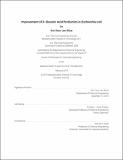Improvement of D-glucaric acid production in Escherichia coli
Author(s)
Shiue, Eric Chun-Jen
DownloadFull printable version (7.456Mb)
Other Contributors
Massachusetts Institute of Technology. Department of Chemical Engineering.
Advisor
Kristala L. Jones Prather.
Terms of use
Metadata
Show full item recordAbstract
D-glucaric acid is a naturally occurring compound which has been explored for a plethora of potential uses, including biopolymer production, cancer and diabetes treatment, cholesterol reduction, and as a replacement for polyphosphates in detergents. This molecule was identified in 2004 as a "Top Value-Added Chemical from Biomass" by the U.S. Department of Energy (Werpy and Petersen, 2004), implying that production of D-glucaric acid could be economically feasible if biomass were used as a feedstock. A biosynthetic route to D-glucaric acid from D-glucose has been constructed in E. coli by our group (Moon et al., 2009b), and the goal of this thesis has been to improve the economic viability of this biological production route through improvements to pathway productivity and yield. One part of this thesis involved the application of metabolic engineering strategies towards improving D-glucaric acid productivity. These strategies targeted MIOX, which had been identified previously as the least active pathway enzyme. Directed evolution of MIOX led to the isolation of a 941 bp DNA fragment which increased D-glucaric acid production 65% from a myo-inositol feed. Fusion of MIOX to SUMO, a eukaryotic post-translational protein tag, significantly increased soluble expression and stability, resulting in a 75% increase in D-glucaric acid production from a myo-inositol feed. A second part of this thesis attempted to apply synthetic biology strategies towards improving pathway productivity. Manual, delayed expression of MIOX via time-resolved addition of chemical inducers was shown to improve productivity approximately five-fold. However, inducers are generally too costly for use in industrial production processes, so we attempted to develop genetic circuits which could delay MIOX expression autonomously, eliminating the need for costly chemical inducers. Although the attempts to create robust, controllable genetic timers in this thesis were unsuccessful, these attempts provided significant insight into limitations currently preventing widespread application of synthetic biology devices to metabolic engineering problems. A third part of this thesis explored strain engineering as a strategy for improving the yield of D-glucaric acid on D-glucose. Deletion of pgi and zwf was demonstrated to prevent E. coli from consuming D-glucose as well as eliminate catabolite repression effects in the presence of D-glucose. Finally, both D-glucaric acid productivity and yield were shown to be increased significantly in this [Delta]pgi [Delta]zwf strain. Overall, this thesis reports significant strides towards commercially viable titers of D-glucaric acid as well as interesting avenues of research for further pathway improvements.
Description
Thesis: Ph. D., Massachusetts Institute of Technology, Department of Chemical Engineering, 2014. This electronic version was submitted by the student author. The certified thesis is available in the Institute Archives and Special Collections. Some pages printed in landscape orientation. Cataloged from student-submitted PDF version of thesis. Includes bibliographical references (pages 133-145).
Date issued
2014Department
Massachusetts Institute of Technology. Department of Chemical EngineeringPublisher
Massachusetts Institute of Technology
Keywords
Chemical Engineering.